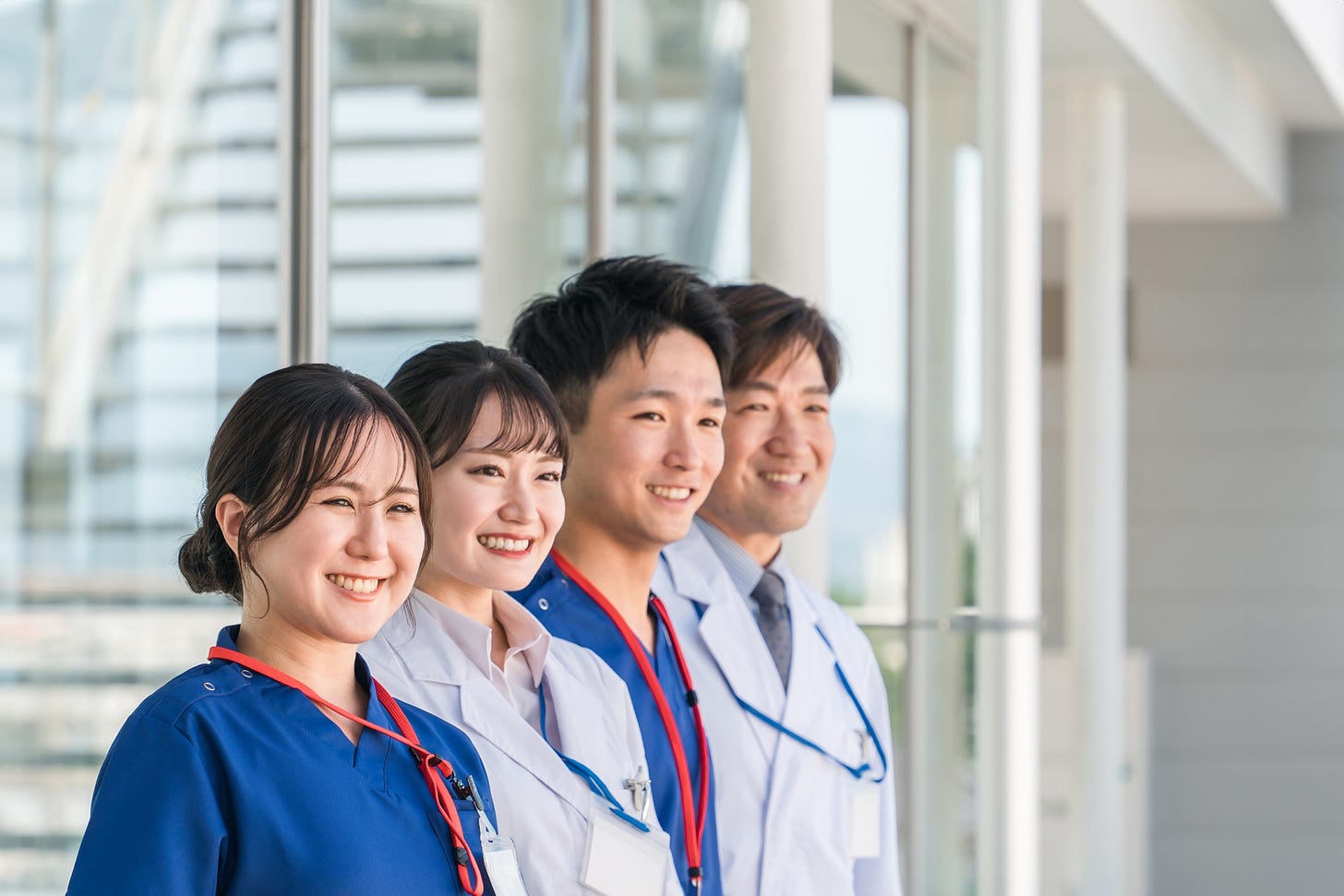

Discover more from Real Gaijin
Japan Must Bridge the Urban-Rural Divide among Doctors
Particularly in maternity and emergency departments, physicians are unevenly distributed in certain regions, leading to acute shortages in rural hospitals.

What’s new: Japan's Ministry of Health, Labor & Welfare (MHLW) recently released new data showing that the urban-rural divide in the distribution of physicians across the country is worsening.
Why it matters: This phenomenon has led to a shortage of doctors in hospitals in certain rural areas, especially in the Tohoku region1. In addition, some medical facilities have been forced to close their maternity wards or reduce their emergency services. The situation is so dire that it may lead to a more serious discussion about whether it's finally time for doctors to relinquish some of their undisputed authority over the management and delivery of medical care in Japan. Perhaps now is the time for advanced practice nurses to gain more autonomy and responsibility. While there is much for the world to learn from how Japan manages its single-payer health insurance system, the country should also consider whether the position of physician assistant would be useful in providing quality health care more equitably across the country.
Go deeper: The uneven distribution of physicians can be roughly divided into two types:
Regional Unbalance: Japanese doctors have a clear preference for working in the urban centers of Tokyo and Osaka, resulting in a shortage of doctors willing to work in rural hospitals. They are driven by a professional desire to learn and practice specialized medical techniques rather than work as general practitioners in the countryside. In addition, many doctors prefer to send their children to elite schools in Japan's megacities rather than have them grow up in the country.
Departmental Unbalance: Rural hospitals also face the particular challenge of finding enough medical staff, including physicians, to manage departments that require a 24-hour system. Such departments include emergency, obstetrics, and general surgery. These specialties typically require on-call physicians to work relatively long hours, and it is a fact that young doctors tend to prefer positions with shorter hours.
By the numbers: Rather than simply characterizing the problem in narrative form, the Japanese government has developed a methodology for quantifying this dilemma.
Quantitative Index: MHLW tracks and publishes a numerical value called the "Doctor Distribution Index" to measure the shortage of physicians. The score is calculated based on factors such as the demand for medical care, the flow of patients in and out of the area, and the number of physicians of each age and gender.
Comparisons by Prefecture: Data can be cross-tabulated by prefecture2. The government is focusing on rebalancing the number of physicians in the 16 prefectures (out of 47 states and territories) with both an excess and a surplus. According to the data released in January this year, there are relatively more "physician shortage prefectures" in eastern Japan and more "physician surplus prefectures" in western Japan. The prefectures with an overall excess of physicians were Tokyo, Kyoto, Fukuoka, Okayama, and Okinawa, in rank order. The lowest ranked prefectures with a shortage of physicians were Iwate, Aomori, Niigata, Fukushima, and Ibaraki. The main problem is in the Tohoku region and some of its neighboring prefectures.
Differences by Age: The number of physicians under the age of 35 per 100,000 people is higher in prefectures with a large number of physicians, such as Tokyo, Okayama, Wakayama, and Kyoto, and lower in prefectures with a small number of physicians, but the difference is shrinking compared with the number of physicians over the age of 40 per 100,000 people, with Akita exceeding the national average.
Ability to Drill down by Region and City: The same database can be used to determine the relative geographic scarcity of physicians on a more granular basis.
Departmental Comparisons: MHLW also tracks the distribution of the country's physicians by 300 secondary medical specialties. Obstetrics and pediatrics tend to be the most at risk for shortages.

What they’re saying: Some doctors are sounding the alarm.
“We will continue to support local healthcare, but we are on the verge of collapse in terms of emergency care, and I feel a great sense of urgency. I would like the government to understand the situation in the countryside and take measures to ensure that rural hospitals can continue to operate.” - Kido Hospital Director Shuichi Sato
The big picture: This problem is just the latest unintended consequence of the country's megatrends, which include depopulation - especially if one excludes the effects of immigration, rapid aging, and the continuing draw of the capital, which in Japanese is called Tokyo ikkyoku shuchu (東京一極集中).
Background: Japan's population has been declining in recent years. It is estimated that by 2070, the total population will fall below 90 million and the proportion of elderly people will reach 39%.
Need for more physicians as a percentage of the total population in the future: Putting it into perspective...
In 1970, there were 2.29 students per 1,000 people aged 18 (about 1 in 436 students went on to medical school).
In 2020, there were 8.10 students per 1,000 people aged 18 (about 1 in 123 students went on to medical school).
In 2050, there will only be 11.8 students per 1,000 people aged 18 (about 1 in 85 students will go on to study at a medical school).

Commentary: My home country, the United States, is struggling with the same problem, though sometimes for different reasons. However, there are some similarities in terms of possible solutions.
The Japanese government seems to be on the right track by expanding its regional quota system, which requires medical school graduates to work in certain regions for a limited number of years. There are, though, calls from the medical frontline for even stronger measures.
"The doctor market is a seller's market, and there are many medical institutions in urban areas that can meet the needs of doctors for a good work-life balance, so I think one of the reasons for the uneven distribution of doctors is that there is little motivation for them to want to work in the countryside. Most employment contracts do not guarantee employment, and the financial situation among many hospitals in rural areas remains very challenging.” - Tomoko Oguma of Recruit Medical Career, an employment information company in Tokyo, which specializes in assisting in the matching of medical personnel nationwide
More attention needs to be paid to recruitment efforts. Hospitals in Japan's largest urban areas can sometimes find applicants within a few days of posting a vacancy, but it is not uncommon for hospitals in rural areas to have no applicants or inquiries for more than a year after posting a help-wanted ad.
There should be more financial incentives to encourage physicians to practice in rural communities. To attract qualified staff, local hospitals need to increase salaries and offer more generous allowances for long-distance commuting and rent. In some cases the provision of actual housing may be warranted. The central government should support such efforts, possibly through tax incentives.

All of these tactics may prove insufficient, however. While such a change would likely face opposition from physician organizations, a more proactive approach to team-based care in which the physician relies on "advance practice nurses" that include certified nurse specialists (CNS) and nurse practitioners (NP), may be the ultimate solution. Such nurses could help deliver care more efficiently in rural areas and staff chronically understaffed departments, if their scope of practice were expanded - possibly to include more prescriptive authority. As in the United States, such nurses could also set up their own clinics, rather than being employed by hospitals and working under the supervision of physicians.
Although it is doubtful that Japanese physicians would ever agree to the creation of a credential similar to that of a physician assistant (PA), a relatively new type of healthcare professional in the U.S. who is empowered to take medical histories, perform physical examinations, order and interpret tests, prescribe medications, provide patient education, and assist in procedures under the supervision of a physician, such an initiative could be another potential solution to this problem in the long term. Currently, there is no equivalent to a physician assistant in Japan.
As a permanent resident in a rural part of the country, I have a personal interest in solving this problem. Although I live in a small town with limited medical resources, I am fortunate to live near a larger city with several major hospitals that can handle almost any medical problem. Last year was the first time I realized how important it is to have easy access to such a hospital. Read "Brush with Disaster at the End of Japan's Golden Week: First-hand account of my week-long stay being poked, prodded, and pricked in a Japanese hospital to recover from a life-threatening illness" to learn more.
What’s next: The central government is taking proactive steps to address this issue.
Attempts to rebalance during clinical training: From the next academic year (2025), the temporary admission capacity of medical schools for prefectures with a large number of doctors will be reduced by 20%. These slots will be allocated to prefectures with a shortage of doctors.
Coordinated effort to adjust regional quotas: The Study Group on Measures to Address the Mismatch in the Distribution of Physicians (医師養成過程を通じた医師の偏在対策等に関する検討会) meets regularly to adjust regional quotas to address this problem.

Role of Telemedicine: While it may be a stopgap measure, telemedicine and telehealth initiatives can improve access to healthcare in rural areas. By connecting patients with specialists, reducing travel, and providing preventive care, it can address physician shortages and improve overall health outcomes.
What do you think? It seems that something has to give to ensure quality care across the country. The question is which solutions make the most sense. With limited resources, trade-offs are a given. What would you recommend? All answers are completely anonymous, even to the author.
Links to Japanese Sources: https://www3.nhk.or.jp/news/html/20240925/k10014592031000.html and https://gemmed.ghc-j.com/?p=60549.
#PhysicianDistribution #PhysicianAssistant #PA #CertifiedNurseSpecialist #CNS #NursePractitioner #NP #telemedicine #telehealth #医師偏在 #厚労省 #医師減少 #医師多数県 #東京一極集中 #認定看護師 #ナースプラクティショナー #遠隔医療
Please note that you can subscribe to Real Gaijin for free. If you are so inclined, you can also purchase an annual subscription for a relatively small fee.
However, I understand that even the lowest level of annual subscription allowed by Substack may seem too high for many. If you just want to buy a coffee for Real Gaijin (or maybe a green tea), you can also make a small donation here:
https://buymeacoffee.com/realgaijin
All levels of support - including just liking a particular article and/or leaving a comment - are very welcome. Thanks again for reading.
While Real Gaijin lives in Substack, you can also find Real Gaijin on a few other platforms (listed in alphabetical order).
https://www.instagram.com/real_gaijin_on_substack/
https://www.threads.net/@real_gaijin_on_substack
https://www.tiktok.com/@real.gaijin
https://www.youtube.com/@RealGaijin
https://www.linkedin.com/in/mark-kennedy-5b50b71/
Northern part of the main island of Honshu.
Equivalent of a state.
Subscribe to Real Gaijin
Unveiling the Real Japan: An American Expat's Inside Look | Hot takes, commentary, and unfiltered insights on life as a foreigner in Japan.























Having more government involved in any part of this won't fix anything. People need to want to be in more rural areas. Making grads be in a certain place for x years, meeting specific quotas, making new laws, etc will only have the opposite effect. Less government, less taxes, less regulation fixes all things. When the free market can decide where, when, how, and how much then things society will find a way to make it work. Government creating artificial scenarios never works.
All of what’s proposed here, much like incentives to relocate families or Kyoto’s tourism problem, don’t look at underlying structural issues, the root cause, which, of course, is complex but boils down to the unfortunate fact that most rural areas have created for themselves by way of the status quo or have had created for them an image of patheticness, a an endlessly repeating spiral of self-defeat.
That’s not what some places actually are, but after so many years of convincing themselves of their podunk-ness, they’ve become rather podunk, assumed that role, and with that comes the whittling away of resources, doctors included. Like any tailspin, it’s hard to come back from - and some, probably many, won’t.
As much as I love Tohoku - I lived in Miyako on the coast of Iwate from 2009-2011, got wrecked by the tsunami there, still have very strong ties - its situation is mostly too far gone to make good use of the resources Japan is able to muster right now to address the issue.
As I do with akiya, there are easy wins, lost causes, and everything in between. What must be done in the short term to affect a more positive long term is to tactically determine those easy wins and achieve them one by one.